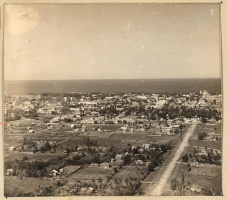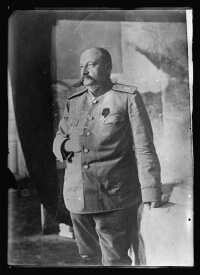The War Begins↑
The Ottoman attack on Russian ships in the Black Sea on 27 October 1914 and the bombardment of Odessa on 29 October, transformed Transcaucasia into a front line. The Georgian port of Poti was shelled on 7 November. The Tsarist Caucasian Army in 1914 consisted of 100,000 infantry and 15,000 cavalry; it was quickly augmented by 150,000 reservists. The Russian Caucasian Army defended a Caucasian front of approximately 720 kilometers which dramatically lengthened as the army pushed into Eastern Anatolia after the defeat of Ottoman forces in Sarikamish in December 1914. Russia’s Caucasian Army faced an Ottoman Third Army of up to 135,000 (mostly concentrated in the 9th, 10th and 11th Corps) in addition to Kurdish irregular cavalry and fifteen battalions of Frontier Guards. Until the February Revolution of 1917, the Caucasian Army fulfilled its mission and kept the Ottoman Army out of Transcaucasia. Ismail Enver Pasha (1881-1922), minister of war and a leading figure in the Young Turk triumvirate which ruled the Ottoman Empire during the war, planned to seize Tiflis (Tbilisi), the ancient capital of Georgia that was Tsarism’s central commercial, administrative, and transport hub in the region. But by the end of 1916, Russia’s Caucasian Army had penetrated over 250 kilometers into the Western parts of the Armenian plateau and along the Black Sea coast, scoring victories in Erzurum, Trebizond, Baiburt, and Bitlis. General Nikolai Yudenich (1862-1933), Russian Commander of the Caucasian front, was poised to break through to Kharput and Sivas in the spring of 1917 after the winter snows had melted. This would have threatened Constantinople. The Caucasian Army’s advance was quickly brought to an end by mass desertions following the revolutionary events in Russia in 1917.
Georgian leaders, and the 140,000 or so Georgians in uniform, were loyal to the war effort and created two small volunteer detachments to fight on the Caucasian front. Georgians had a long history of conflict with the Ottoman Empire and were fearful of its expansion into the Transcaucasian region. The last war fought by the Ottomans on Georgian territory was in 1877-1878, which ended with the Treaty of Berlin in 1878, and the loss of Ottoman lands to the Russian Empire. In the Georgian mind, the Ottoman Turks were the civilizational “other” — brutal, “Asiatic,” and despotic. Georgian political parties, after the fall of the Russian monarchy in February 1917, remained committed to the new Russian state, but news of the overthrow of the Russian Provisional Government in October 1917, led to demands in Transcaucasia for regional power. The Bolshevik victory in Petrograd led Transcaucasia’s parties, dominated by the predominantly Georgian Transcaucasian Regional Committee of the Russian Social Democratic Labor Party (RSDLP), to establish a Transcaucasian Commissariat, though there was no desire at this stage to separate from Russia. A Transcaucasian Sejm was created in February 1918 after the Bolshevik dissolution of the Constituent Assembly in January 1918. The dismissal of the Russian Constituent Assembly marked the beginning of civil war throughout the former Russian Empire, and on 22 April 1918, an independent Transcaucasian Democratic Federative Republic (TDFR) was established. The TDFR formed a new government which was led by a delicately balanced coalition cabinet of Georgians, Armenians, and Muslim Azerbaijanis, each represented by a national party. The Georgians led the Transcaucasian Regional Committee of the RSDLP (in November 1918, it renamed itself the Georgian Social Democratic Labor Party—or GSDLP); the Armenians were represented by the Dashnaktsutiun (the Armenian Revolutionary Federation) and the Azerbaijanis by the Müsavat (Equality). In reality, identities in the South Caucasus were far more multiple, based on religion, region, language, dialect, and class. No clear territorial lines could be drawn between Transcaucasia’s national groups, and categories like “nation” were vague and blurred entities.
Georgia Adrift↑
The collapse of the Caucasian front and the departure of Bolshevized Russian soldiers from Tiflis over the winter of 1917-1918, left Transcaucasia open to the territorial ambitions of the Young Turks, whose goal was the elimination of Armenian resistance, control of the strategic railway system that linked Baku, Tiflis, and Batumi, and the capture of the Azerbaijani capital of Baku, with its rich oil resources. The Brest–Litovsk Treaty of March 1918 between the Ottomans and the Central Powers (dominated by Germany) on the one hand, and Soviet Russia on the other, was a step toward this goal. Under the treaty’s terms, the Ottoman vilayets of Kars, Ardahan, Artvin, Oltu, Khargyzman, and Batumi — all part of the Russian state since 1878 — were to be returned to the Ottomans. This was a death blow to the new Transcaucasian authorities and was traumatic to Georgians, who regarded Batumi and parts of Ardahan and Artvin to be historically Georgian territories. The treaty left Transcaucasia militarily defenseless. Negotiations between the Transcaucasian government and the Ottoman authorities in Trabzon and Batumi from March to May 1918, during a period of social and economic upheaval in Transcaucasia, exposed the incompatible interests of Transcaucasia’s national elites. On 26 May 1918, with the backing of the German government, which saw Georgia as a crucial component in its own ambitious policy in the Middle East, the Georgian National Congress declared independence.
Germany’s Drang nach Osten (Drive to the East) was designed to challenge British dominance in the Middle East and acquire raw materials such as oil. Georgia was seen as a potential “bridge” to the Orient. Before the war, Georgia had produced about one-third of the world’s manganese, and Germany imported around 41 percent of total Georgian production (the mines were in Chiatura, West Georgia). Manganese was essential to the production of steel. Zurab Avalishvili (1876-1944), one of Georgia’s most astute diplomats, later commented in his memoir that “the rivers and (water) falls of the Caucasus were transformed into millions of mettlesome horses (h.p.) in steel harness, ready to pull the chariot of German capitalism into the very depths of Asia.”[1] On 3 June, following agreements signed with the newly independent Georgian state in the Black Sea port of Poti on 28 May 1918 (known as the Poti Agreements), two German battalions arrived in Georgia from Crimea, along with the 217th Infantry division from Ukraine. By the end of September, Germany had over 19,000 soldiers and officers stationed in newly independent Georgia, including artillery, sappers, and armored vehicles. The German army trained Georgian recruits, provided aviation and artillery support, helped suppress “Bolshevik” unrest, and most importantly, contained Ottoman threats. But the anticipated profitable economic exchange between Germany and Georgia never materialized, and Georgians, it turned out after the defeat of Germany in November 1918, had backed the wrong horse.
Conclusion↑
The German military and diplomatic missions in Georgia ended in failure. German forces were unable to secure Baku or prevent Turks seizing the oil city of Baku in September 1918. After the victory of the Entente in October 1918, the Mudros Armistice, signed on 30 October, sanctioned the replacement of Ottoman and German troops in Transcaucasia by British forces.
The British never clarified their strategy in Georgia and Transcaucasia, though their presence in Georgia was designed to prevent Bolshevik expansion into the Middle East, and to exploit the region’s oil, manganese, and transit resources. They inherited from the Germans a country in turmoil and in a state of economic collapse. The war had led to blockades in the Bosporus, and the economies of the newly independent Caucasian states, including Georgia’s, went into rapid decline during the war, and never recovered. The Georgian ports of Batumi and Poti lost their commercial significance, and work in the Chiatura manganese mines and in other extractive industries practically stopped. The factory workforce in Georgian territories almost halved between 1914-1917 as workers left for the villages or joined the army. Prices increased between 300 and 400 percent and wages did not keep up. The British, after much internal debate on their purpose in Georgia, and tied up in territorial disputes between the three Transcaucasian states of Armenia, Azerbaijan, and Georgia, pulled out most of their 20,000 or so troops by the summer of 1919. On 21 July, the last British soldiers, based in the strategic Black Sea port of Batumi, were evacuated. Unprotected, the Democratic Republic of Georgia lasted another eight months before it was overrun by the Red Army in February and March 1921.
Stephen F. Jones, Mount Holyoke College
Section Editor: Nikolaus Katzer
Notes
- ↑ Zourab Avalishvili: The Independence of Georgia in International Politics, 1918-1921, Westport 1981, p.96
Selected Bibliography
- Allen, William Edward David / Muratoff, Paul: Caucasian battlefields. A history of the wars on the Turco-Caucasian border, 1828-1921, Cambridge 1953: Cambridge University Press.
- Avalishvili, Zourab: The independence of Georgia in international politics, 1918-1921, Westport 1981: Hyperion Press.
- The Transcaucasian Democratic Federative Republic of 1918. Federal aspirations, geopolitics and national projects, in: Caucasus Survey 8/1, 2020, pp. 1-125, 2020.
- Forsyth, James: The Caucasus. A history, Cambridge 2015: Cambridge University Press.
- Rayfield, Donald: Edge of empires. A history of Georgia, London 2019: Reaktion Books.
- Suny, Ronald Grigor: The making of the Georgian nation, London 1989: I. B. Tauris.











